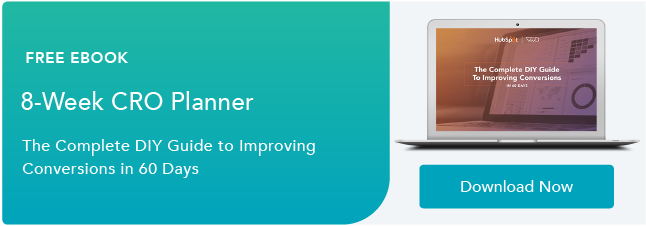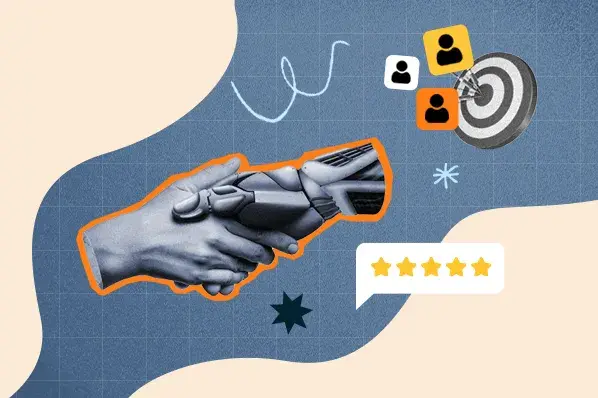A lead goes through several stages before becoming a customer. They start as a lead, then grow into a marketing-qualified lead (MQL), and then become a sales-qualified lead (SQL). This means brands have to nurture their leads at every stage and create opportunities for them to take action toward becoming customers.
No two brands have the same process, as each will build a conversion path that is tailored to its leads. Below you'll find a few tips on creating a lead generation strategy for your own business.
1. Gather information on leads.
Start with the data you have on your leads: source, industry, company, employee size, pain points – any information that will help you build a strategy that aligns with your leads' needs.
Remind me to trademark "leads' needs" after writing this article. Now, back to the important stuff.
"You will waste a lot of time building out a conversion strategy that is not based around facts about your audience," says Marwa Greaves, Director of Global Messaging at HubSpot. "Ask yourself where your leads are. Are your leads most engaged in your newsletter? Your website? On messaging channels? Make sure you are meeting your audience where they are and not asking them to bend to your strategies."
Jordan Pritikin, the Head of Email and Growth Marketing at HubSpot, also highlights another important element to consider.
"Understand why these leads are coming to your website in the first place. What is the underlying problem they are trying to solve?" says Pritikin. "If you can create email nurturing to help them solve that challenge, you're much more likely to connect with them and convert them into a new customer."
If you're missing that information, work on obtaining it through forms and user research. From there, you can design a tailored conversion process.
2. Identify high-intent behaviors in each stage.
How do you know when a lead is ready to make a purchase? What behaviors will the lead exhibit? Having these answers is key to differentiating between leads who are ready to make a purchase and those who aren't.
A lead who only reads your brand's blog posts is likely not at the same purchase readiness as a lead who visits your pricing page. So, if you send an unqualified lead to the sales team, they will likely have a much harder time closing a sale.
How do you avoid that? Team up with your sales team to determine what signals low-intent and high-intent behaviors. Specifying those behaviors allows marketers to know what follow-up actions to take.
3. Use an SLA to align your sales and marketing teams.
A lead conversion strategy will struggle immensely without alignment between sales and marketing. One thing you'll need to agree on is a handoff cadence that works for both teams. That's where a service-level agreement (SLA) comes in.
It's typically used to outline an agreement between a business and a customer. However, it's also used internally between sales and marketing teams to better align their lead conversion strategy.
An internal SLA should include each team's goals, initiatives, and accountability measures for a given time frame, say Q1. That said, this agreement will require regular updates as priorities change with the business.
4. Build the lead conversion path.
Think of your lead conversion path as a trail of breadcrumbs guiding your leads to purchase. The path itself will include offers and calls-to-action to offer opportunities to convert.
Lead Conversion Strategy Example
Let's use Zion, a fictional UK SaaS company, as an example. Zion's sales and marketing teams have collaborated on an SLA, which includes the following: Marketing commits to sending 100 qualified leads to the sales team every month and the sales team commits to following up with those leads within a week of receiving them.
Both teams have also identified high-intent behaviors that will trigger automated emails and have implemented a lead scoring system. For instance, when a lead reaches a score of 95, this will automatically trigger an email sequence inviting the lead to schedule a product demo with a sales rep.
On the back end, that sales rep will receive a notification containing information on the lead, their activity, and a follow-up timeline. If the lead does not take action within a certain time frame, an automated, personalized email will be sent to the lead on behalf of the sales rep.
This is an example of the path Zion can build to convert leads, both on the customer-facing end and on the back-end between sales and marketing.
How To Calculate Lead Conversion
Calculating your lead conversion rate is simple: Take your total number of conversions, divide that by your total number of leads, and multiply by 100. That final number is your LCR.

Example time: Let's say from January to February, you generated 105 qualified leads. From those leads, 20 became customers. The formula will look like this: 20/105 x 100. This means the lead conversion rate for that month was 19.04%.
Average Lead Conversion Rates
Because lead conversion happens at several stages across various touchpoints, no single average can be used across industries.
Your brand would benefit more from looking at conversion rates at a more granular level, such as by channel (i.e., email conversion versus landing page conversion) and/or by stage (i.e., MQL-to-SQL rate).
Lead Conversion Strategies
1. Implement behavior automation.
There are two reasons to use automation: it saves time, and it scales well.
Let's say a lead is sifting through testimonials on your website. That may indicate an interest in your product. With this in mind, why not automate a follow-up email that could bring the lead one step closer to a purchase? This could be a free trial offer or a product demo.
According to Pritikin, emails based on behavior perform much better than other types of automated emails. However, Greaves encourages brands to broaden their perspective when defining those behaviors that suggest purchase readiness.
"Activity-based triggers are an easy win for marketers, but think outside the box when creating them," Greaves says. "It's not just views on your pricing page that may require an automated follow-up, it could also be views of other customer stories or reviews on your site."
Here is a list of behaviors that could benefit from automation. The lead:
- Reviews your pricing page
- Schedules a product demo
- Signs up for a free trial
- Engages often in email marketing
- Inquires about product features through chatbot, email, or other channels
- Downloads a high-intent content offer
Working with your sales team to recognize those key behaviors will be instrumental in automating follow-ups that convert.
2. Nurture your leads through email.
Email nurturing is the process of engaging your leads through email marketing with the end goal of turning them into customers. When nurturing leads via email, offering relevant and valuable information is key.
This is when the data piece becomes important. Using the information you've compiled on your leads, you can deliver content that piques their interest, aligns with their goals, and solves their challenges.
There are a few tips to make your emails stand out:
- Personalize your emails with the lead's name.
- Use automation software to trigger actions based on email engagement.
- Segment your email list.
3. Leverage social proof.
When leads are considering your products or services, social proof can help nudge them toward a purchase. Examples of social proof include customer testimonials and reviews, which give leads a look into customers' experiences with your brand.
They are best used when leads are in (or close to) the decision-making stage. So, you'll often see them on landing pages and pricing pages.
User-generated content is another great use of social proof and can be incorporated into your social media and email marketing content.
4. Use lead scoring.
If you're having trouble aligning your sales and marketing teams on MQLs and SQLs, lead scoring can help.
Lead scoring works by attributing points to actions taken by leads and helps marketers know where a lead falls in the funnel. It also helps sales reps prioritize leads and know which follow-up actions to take. It also ensures that both teams are qualifying leads in the same way.
A well-qualified lead means one that's more likely to convert once they reach your sales team.
5. Retarget through PPC.
Retargeting is a great way to reach leads that have considered your brand before but weren't quite ready to make a purchase. When you retarget them, you can re-introduce offers they may be interested in or present new ones that align better with their interests.
Retargeting is a proven method for lead generation. However, according to Greaves, it can also work well to turn leads into qualified leads. With the latest restrictions on cookies – commonly used for retargeting ads – brands will have to rely more on first-party data for their retargeting efforts.
Let's go over some additional aways you can generating more leads.
1. Start with the analytics.
If your lead conversion is low, your first step should be looking at your analytics. Specifically, your conversion path over a broad time frame to determine if the low rate has been consistent or is recent.
If it's the latter, narrow down the period when the dip started and see what could have led to this change. If it's been consistent, you may need to run various experiments with your conversion path.
Greaves recommends looking at your conversion CTA placements and the difference between them. You'll want to look for the difference between high-performing and low-performing CTAs. If there are steep drop-offs on certain pages, that could indicate friction with your forms, like the length or the order of the fields, or even the type of information requested.
If the data shows that leads drop off shortly after the handoff to the sales team, it could be that marketing over-promised on what could be delivered.
With so many potential causes, start with the data to lead you in the right direction. Pun intended.
2. Define what high-intent behavior means for your business.
Many brands may have lead qualification issues and not even know it. Marketing may be sending their sales team leads and later realize that those leads aren't ready for sales engagement.
How do you identify the leads that are ready? It starts with gathering the correct information. First, reach out to your sales team to determine what information needs to be collected. Then, create a comprehensive list of high-intent behaviors and low-intent behaviors that the marketing team will use to segment leads.
This process can help pass on more qualified leads to the sales team and drive your conversion rate up.
3. Experiment with the conversion path.
Think of your lead conversion path as a house. I know you might be thinking, "Why not go with a road metaphor?" but stick with me for a second. Regardless of the condition in which you buy your house, there will always be room for improvement. Things to remove, fix, add, and revamp. And as your tastes change, so will your house's look.
It's the same with your path. There will always be room to improve your path. Besides, your leads' interests, goals, and decision-making processes may change over time and require a different approach.
"Lead conversion requires a lot of experimentation. You will not succeed if you set one strategy and forget it," Greaves says. "Creating an experimentation process that allows you to test every part of your flywheel will allow you to learn more about your leads and your own internal process than you would have before."
Although the work is never fully done, every experiment you run will bring you that much closer to converting your leads.
4. Automate lead nurturing workflows.
When trying to scale your lead nurturing process, automation is the name of the game. Manually sending out personalized emails to your leads might have worked in the early days, but that will quickly get overwhelming as your business grows.
Automation allows you to maintain the same level of personalization at a quarter of the time and resources. Once you've set up your conversion path, automate the follow-ups that will be triggered when leads exhibit certain behaviors.
These tactics can not only save your team time but also streamline the conversion process so that no lead falls through the cracks. This practice also leaves room for your sales and marketing team to focus on big-ticket items.
The key takeaway here is that lead conversion isn't a one-and-done process. It calls for strategy, cross-team collaboration, and a whole lot of experimentation.
Conversion Rate Optimization
.png?width=112&height=112&name=Image%20Hackathon%20%E2%80%93%20Horizontal%20(37).png)






![What We Didn’t Do Boosted Our Paid Ad CVR by 11% [Expert Interview]](https://53.fs1.hubspotusercontent-na1.net/hubfs/53/hubspot-labs-paid-ad-cvr.webp)




![What is a CRO Test? [+ the 5 Steps to Perform Them Yourself]](https://53.fs1.hubspotusercontent-na1.net/hubfs/53/conversion-rate-optimization-tests_4.webp)